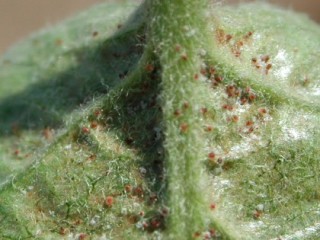
Fruit tree red spider mite is an important secondary pest of apple.
The varieties Discovery, Gala and Worcester Pearmain are highly susceptible to fruit tree red spider mite.
Fruit tree red spider mite has a simple life cycle, overwintering as eggs on the bark, mainly around fruiting spurs. Eggs hatch in late April or May, around blossom time of apple. Young mites then invade the leaves and trusses.
There are five or six successive generations of adults, mainly on the undersides of leaves, before eggs are laid on bark in the autumn. All stages are readily recognised.
The pest is seldom a problem in orchards where the orchard predatory mite Typhlodorums pyri is established. It is important to regularly monitor levels of the pest and the preadator.
The presence of high populations of fruit tree red spider mite which causes leaf bronzing damage and fruit russeting is an indication of failure of proper integrated mite management. The predatory mite should be introduced, by transferring summer prunings in summer to newly planted orchards and to orchards where it is absent.
Pesticides harmful to the orchard predatory mite should not be used except as a last resort, as they cause outbreaks of rust and spider mites.
Chemical control
Where high populations of overwintering eggs occur, a high volume spray of clofentezine (Apollo) or hexythiazox (Nissorun) should be applied before blossom and before hatching of overwintering eggs commences. Both products work only on the eggs and early motile stages of the pest and are ineffective against the adults, so application timing is critical.
Where damaging populations occur after blossom, a spray of acequinocyl (Kanemite), cyflumetofen (Nealta), fatty acids (Flipper) or tebufenpyrad (Shirudo) should be applied.
A full approval for spirotetramat (Batavia) on apples for the control of sucking insect pests will control fruit tree red spider mite, but growers may prefer to reserve its use for more difficult to control species such as woolly aphid and rosy apple aphid. It must be applied after flowering and works best when pests are moving from brown wood to green tissue. It will prevent population build-up but does not offer pest ‘knockdown’.
The bioinsecticide fatty acids (Flipper) has an EAMU approval for use on apples. It is effective at controlling sucking insect pests such as aphids, whitefly and mites, so is likely to control fruit tree red spider mite. It is known to complement the use of Batavia as it provides quick ‘knockdown’. Its safety to beneficial insects such as Typhlodromus pyri and the parasitic wasp Platygaster demades is unknown, but it is generally safe to many other predators and parasitoids, so is considered to be more suitable to IPDM programmes than the synthetic pyrethroids.
Insecticides, acaricides and fungicides approved for use on apple which are recommended to control fruit tree red spider mite or offer some incidental control when applied to control other pests or diseases
Choice of products - efficacy factors |
|||||
|---|---|---|---|---|---|
| Active ingredient | Trade name (examples) | Class | Selectivity | Approved for control of | Safety to Typhs |
| acequinocyl | Kanemite | acaricide | Selective | Fruit tree red spider mite, two-spotted spider mite | safe |
| clofentezine | Apollo | acaricide, ovicidal | Selective | Winter eggs of fruit tree red spider mite and rust mite | safe |
| cyflumetofen | Nealta | acaricide | Selective | Fruit tree red spider mite, two-spotted spider mite | safe |
| fatty acids | Flipper (EAMU 3419/19) | bioinsecticide | Selective | Aphids, blossom weevil, two-spotted spider mite | unspecified but generally safe in IPDM programmes |
| hexythiazox | Nissorun | acaricide, ovicidal | Selective | Two-spotted spider mite | harmful |
| spirotetramat | Batavia | tetramic acid derivative | Selective | Sucking insect pests | unclassified |
| sulphur | various | fungicide and acaricide | Selective | Scab and mildew on apples and pears. Gall mite on black-currants. | inter-mediate |
| tebufenpyrad | Shirudo | acaricide and aphicide | Selective | Red spider mite in apples and pears. | unclassified |
|
Choice of insecticides - Safety factors Read the lable before apply any sprays |
|||||||
|---|---|---|---|---|---|---|---|
| Hazards | Harvest interval (days) | Max no. sprays or dose | Buffer zone width (m) | ||||
| Anticholin-esterase? | Humans | Fish & aquatic life | Bees | ||||
| acequinocyl | no | h, i | t | u | 30 | 1 | 20 |
| clofentezine | no | u | t | u | 35 | 1 | u |
| cyflumetofen | no | h, i | t | u | 14 | 1 | 15 |
| fatty acids | no | h, i | h | u | 0 | 8 | 20 |
| hexythiazox | no | h, i | t | u | 28 | 1 | 15-30 depending on time of application |
| spirotetramat | no | h, i | t | d | Start of ripening | 2 | 10 |
| sulphur | no | u | u | u | 0 | Varies with product | u |
| tebufenpyrad* | no | h | ed | d | 7 | 1 | 30 |
| Keys: d=dangerous, e=risk of serious damage to eyes, ed=extremely dangerous, h=harmful, ir=irritant, t=toxic u=unspecified or unclassifiedCSI=chitin synthesis inhibitor* not recommended for use with hand-held sprayers | |||||||
Control in organic orchards
Emphasis should be placed on natural control by the orchard predatory mite Typhlodromus pyri (see ‘Cultural and biological control’) .
- Application of foliar sprays of fatty acids, which are harmful to the predatory mite, should be avoided unless absolutely necessary.
- Programmes of sprays of sulphur to control scab and mildew can also be harmful to the predatory mite though populations tolerant of the sulphur appear to develop eventually.
